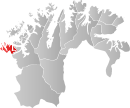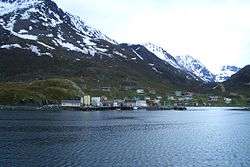Loppa
| Loppa kommune Láhpi suohkan Lappean komuuni | |||
|---|---|---|---|
| Municipality | |||
|
Øksfjord village | |||
| |||
 Loppa within Finnmark | |||
| Coordinates: 70°14′22″N 22°20′55″E / 70.23944°N 22.34861°ECoordinates: 70°14′22″N 22°20′55″E / 70.23944°N 22.34861°E | |||
| Country | Norway | ||
| County | Finnmark | ||
| District | Vest-Finnmark | ||
| Administrative centre | Øksfjord | ||
| Government | |||
| • Mayor (2007) | Jan-Eirik Jensen (Kp) | ||
| Area | |||
| • Total | 687.30 km2 (265.37 sq mi) | ||
| • Land | 669.35 km2 (258.44 sq mi) | ||
| • Water | 17.95 km2 (6.93 sq mi) | ||
| Area rank | 162 in Norway | ||
| Population (2014) | |||
| • Total |
1,027 ( | ||
| • Rank | 401 in Norway | ||
| • Density | 1.49/km2 (3.9/sq mi) | ||
| • Change (10 years) | -20.6 % | ||
| Demonym(s) | Loppværing[1] | ||
| Time zone | CET (UTC+1) | ||
| • Summer (DST) | CEST (UTC+2) | ||
| ISO 3166 code | NO-2014 | ||
| Official language form | Bokmål | ||
| Website |
www | ||
|
| |||
Loppa (Northern Sami: Láhpi and Kven: Lappean) is a municipality in Finnmark county, Norway. The administrative centre of the municipality is the village of Øksfjord. Other villages in Loppa include Andsnes, Bergsfjord, Langfjordhamn, Loppa, Nuvsvåg, Øksfjordbotn, Sandland, and Sør-Tverrfjord.
Most people live in the village of Øksfjord, but smaller communities are spread out along the shores and islands, notably Nuvsvåg, Sandland, Bergsfjord, Brynilen, and the island of Loppa. This island was previously the administrative centre of the municipality (hence the name). There is no airport, but Øksfjord is a port of call for the Hurtigruten boats.
General information


The municipality of Loppa was established on 1 January 1838 (see formannskapsdistrikt). In 1858, the northern part of Loppa on the island of Sørøya and most of Loppa on Stjernøya (population: 506) was separated to form the new municipality of Hasvik. This left Loppa with 801 residents. The borders of the municipality have not changed since that time.[2]
Name
The municipality is named after the island of Loppa (Old Norse: Loppa), since it was the former centre of the municipality and the first church (Loppa Church) was located there. The meaning of the name is uncertain. Historically, the name was spelled Loppen.[3][4]
Coat-of-arms
The coat-of-arms is from modern times. They were granted on 19 December 1980. The arms show a great black cormorant on a gold background. The cormorant was chosen as a symbol since the municipality has several typical fishing villages which often attract cormorants.[5][6]
Churches
The Church of Norway has one parish (sokn) within the municipality of Loppa. It is part of the Alta deanery in the Diocese of Nord-Hålogaland.
| Parish (sokn) | Name | Location | Year built |
|---|---|---|---|
| Loppa | Bergsfjord Church | Bergsfjord | 1951 |
| Loppa Church | Loppa | 1953 | |
| Nuvsvåg Chapel | Nuvsvåg | 1961 | |
| Sandland Chapel | Sandland | 1971 | |
| Øksfjord Church | Øksfjord | 1954 |
Government
All municipalities in Norway, including Loppa, are responsible for primary education (through 10th grade), outpatient health services, senior citizen services, unemployment and other social services, zoning, economic development, and municipal roads. The municipality is governed by a municipal council of elected representatives, which in turn elect a mayor.
Municipal council
The municipal council (Kommunestyre) of Loppa is made up of 15 representatives that are elected to every four years. Currently, the party breakdown is as follows:[7]
| Party Name | Name in Norwegian | Number of representatives | |
|---|---|---|---|
| Labour Party | Arbeiderpartiet | 6 | |
| Conservative Party | Høyre | 5 | |
| Centre Party | Senterpartiet | 2 | |
| Socialist Left Party | Sosialistisk Venstreparti | 2 | |
| Total number of members: | 15 | ||
Geography
Loppa is the westernmost municipality of Finnmark and it faces the open stretch of the Norwegian Sea called Lopphavet, and it is mostly coastal with fjords and islands under the gigantic snowcap of the Øksfjordjøkelen glacier. The municipality includes most of the peninsula between the Kvænangen and the Altafjorden. There are also several islands in the municipality, notably Loppa, Silda, and part of Stjernøya. The mountains Lopptinden and Svartfjellet both lie in the municipality along with the glaciers Langfjordjøkelen, Øksfjordjøkelen, and Svartfjelljøkelen.
Climate
| Climate data for Øksfjord | |||||||||||||
|---|---|---|---|---|---|---|---|---|---|---|---|---|---|
| Month | Jan | Feb | Mar | Apr | May | Jun | Jul | Aug | Sep | Oct | Nov | Dec | Year |
| Daily mean °C (°F) | −3.7 (25.3) |
−3.5 (25.7) |
−2.1 (28.2) |
0.7 (33.3) |
4.8 (40.6) |
8.9 (48) |
12.1 (53.8) |
11.3 (52.3) |
7.7 (45.9) |
3.5 (38.3) |
−0.2 (31.6) |
−2.6 (27.3) |
3.1 (37.6) |
| Average precipitation mm (inches) | 73 (2.87) |
67 (2.64) |
57 (2.24) |
52 (2.05) |
46 (1.81) |
52 (2.05) |
59 (2.32) |
71 (2.8) |
80 (3.15) |
105 (4.13) |
82 (3.23) |
86 (3.39) |
830 (32.68) |
| Source: Norwegian Meteorological Institute[8] | |||||||||||||
References
- ↑ "Navn på steder og personer: Innbyggjarnamn" (in Norwegian). Språkrådet. Retrieved 2015-12-01.
- ↑ Jukvam, Dag (1999). "Historisk oversikt over endringer i kommune- og fylkesinndelingen" (PDF) (in Norwegian). Statistisk sentralbyrå.
- ↑ Rygh, Oluf (1924). Norske gaardnavne: Finmarkens amt (in Norwegian) (18 ed.). Kristiania, Norge: W. C. Fabritius & sønners bogtrikkeri. pp. 93–94.
- ↑ Store norske leksikon. "Loppa" (in Norwegian). Retrieved 2013-01-09.
- ↑ Norske Kommunevåpen (1990). "Nye kommunevåbener i Norden". Retrieved 2008-12-11.
- ↑ "Kommunevåpen". Flags of the World. 28 June 2002. Retrieved 2008-12-11. External link in
|publisher=(help) - ↑ "Table: 04813: Members of the local councils, by party/electoral list at the Municipal Council election (M)" (in Norwegian). Statistics Norway. 2015.
- ↑ "eKlima Web Portal". Norwegian Meteorological Institute.
External links
 Media related to Loppa at Wikimedia Commons
Media related to Loppa at Wikimedia Commons


